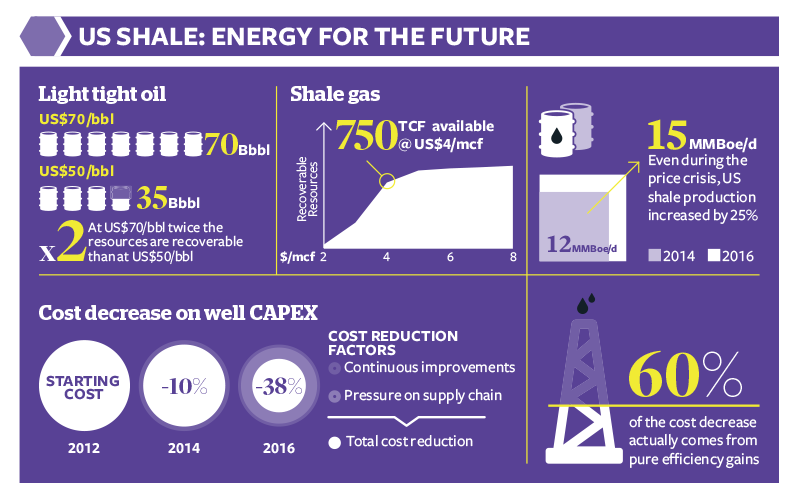US shale roars back
Buoyed by renewed interest, the North American shale energy industry is on the brink of a new era, write Ivan Marten, Eric Oudenot and Emmanuel Ricolfi.

US shale and Canada’s oil sands will be big contributors to supply growth in coming years. As new projects open and OPEC acknowledges their significant role in the oil market, consultants at The Boston Consulting Group analyse these two pillars of North America’s energy security.
Despite the substantial decline in oil prices that began in July 2014, US shale oil and shale gas producers have shown a tremendous resilience over the past 36 months. In fact, during that period US shale jumped from 12m barrels of oil equivalent per day (Boe/d) to nearly 15m in 2017.
The secret of this resilience lies in the operators’ ability to consistently deliver efficiency gains, quarter after quarter, leading to an ever decreasing breakeven point for US shale basins. As a result, The Boston Consulting Group (BCG) estimates that 50% of all US light tight oil recoverable resources are now economical below US$60/Boe and 75% below US$70/Boe.
Efficiency and productivity gains
The cost decrease has been impressive both on CAPEX and on OPEX required. Drilling CAPEX has continued to decrease by approximately 12–15% per year and service costs for some key OPEX categories have dropped by 40–50% since 2014. Although some of these performance gains are conjectural and driven by drops in supply price, 60% of the price decrease actually comes from pure efficiency gains. In the Midland basin for example, the latest BCG study calculated that 30% of savings are driven by innovation and design and 25% by planning and execution efficiency.
In addition, BCG data shows that the average estimated ultimate recovery, or lifetime production, per US shale well increased by 35%: from 530 to 717m Boe. As a result, the average CAPEX per barrel of shale oil equivalent fell by 23%, from US$13.25 to US$10.21, while the average number of drilling days per well fell by more than 30%.
Low oil and gas prices have led to a natural selection amongst the US shale basins. Acreage quality and access to the midstream sector became critical. A drastic refocus in basins has happened in the last three years. The five major basins – Permian, Eagle Ford, Marcellus, Delaware and Bakken – now account for 75% of the total US shale production with nearly 11m Boe/d, against only 50% in 2012.
Industry resilience
Comparing US shale with other asset classes shows just how resilient shale has been. Across the globe, low oil and gas prices have had severe impact on planned investments in oil sands, heavy oil, deepwater, and even in mature shallow water or onshore basins. Major project sanctions have been at a virtual standstill in Angola, Australia, Canada, Nigeria, the UK and many other countries. In a ‘lower for longer’ world the profitability and competitiveness of these asset classes is openly questioned by management teams of international oil companies (IOCs).
 Renewed confidence drives resurgence
Renewed confidence drives resurgence

All this has set the scene for a resurgence of US shale. Four different elements clearly highlight this trend. Firstly a number of IOCs have given a strategic vote of confidence for US shale. Chevron, ExxonMobil and Shell have all announced their intent to continue investing significantly in US shale plays. Shell recently announced that it would accelerate its plans to boost its shale production to reach 500,000Boe/d. Chevron has also stated its ambition for 500,000Boe/d and ExxonMobil for 800,000Boe/d by 2025. It is estimated that in 2017 all three companies will invest close to US$10bn in US shale.
Secondly, an intense wave of mergers and acquisitions (M&A), mostly centred around Permian and Marcellus acreage, driven by independents and private equity backed companies has demonstrated the appetite for US shale. Since Q1 2016 M&A activity on these two basins has reached US$61bn. For instance in the Permian, ExxonMobil announced a US$6.6bn deal in January 2017, Noble invested US$2.7bn to acquire acreage from Clayton Williams, and Carrizo acquired acreage for US$750m in June 2017 (at US$22,000 per acre). In the Marcellus, EQT acquired Rice for US$8.2bn in June 2017, while Noble sold its acreage for US$1bn in May 2017.
Thirdly, there has been a spectacular increase in US land rig count: over the past 12 months the number of active land rigs in the US has doubled, growing from 440 to 931. Most of this increase is driven by shale oil plays, including approximately 200 new rigs focused on the Permian. This increase in rig count, coupled with the continuous improvement in drilling time may trigger a significant increase in US shale production.
Finally, operators keep finding new basins, new horizons and at the same time continue to improve the effectiveness of their supply chain and their completion techniques, leading to more and more barrels of reserves being added – thus extending the lifetime and the robustness of US shale.
As a result, shale has become the main pillar of the US energy landscape. The latest report from the US Potential Gas committee published in July 2017 showed that shale now accounts for 64% of US gas reserves.
Growing importance set to continue
The past three years have demonstrated that US shale is not a ‘bubble’ nor a ‘house of cards’, it is a fundamentally sound asset class, which is much more adapted to a low commodity price environment than most other asset types. We believe that the importance of shale, in the US and potentially across the globe (Argentina, China and Russia), will continue to grow in the coming years.
By Ivan Marten, Senior Partner and Managing Director, Vice Chairman Energy Practice, Eric Oudenot, Partner and Managing Director, and Emmanuel Ricolfi, Project Leader, The Boston Consulting Group






Follow us
Advertise
Free e-Newsletter